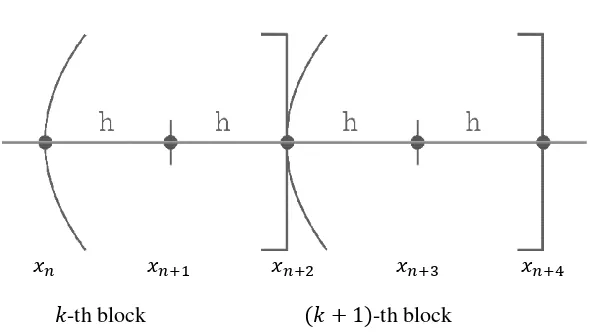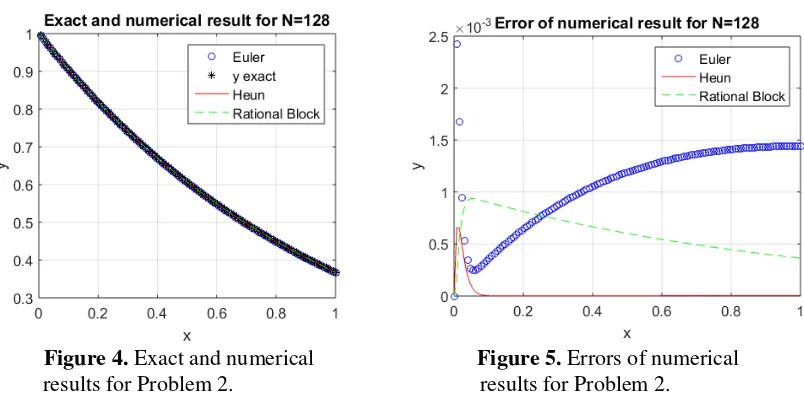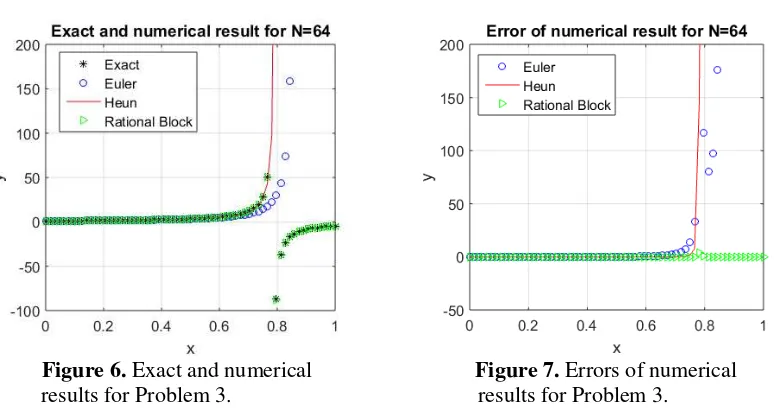This content has been downloaded from IOPscience. Please scroll down to see the full text.
Download details:
IP Address: 202.94.83.84
This content was downloaded on 11/02/2017 at 06:17
Please note that terms and conditions apply.
Runge-Kutta and rational block methods for solving initial value problems
View the table of contents for this issue, or go to the journal homepage for more
Runge-Kutta and rational block methods for solving initial
value problems
Sudi Mungkasi and Agung Christian
Department of Mathematics, Faculty of Science and Technology,
Sanata Dharma University, Mrican, Tromol Pos 29, Yogyakarta 55002, Indonesia
E-mail: [email protected], [email protected]
Abstract. Three methods to solve initial value problems are considered. The methods are the first order Euler's, second order Heun's, and rational block methods. The Euler's and Heun's methods are of the Runge-Kutta type. Numerical results show that the rational block method is more robust than Runge-Kutta type methods in solving initial value problems.
1. Introduction
Mathematical models are very useful to solve real problems [1-4]. A class of mathematical models is ordinary differential equation (ODE). To solve ODEs in practice, we must have an initial condition and they form an initial value problem. There are a number of methods to solve initial value problems, such as Runge-Kutta methods and rational block methods.
In this paper, we solve initial value problems using the first order Runge-Kutta (Euler's) method, second order Runge-Kutta (Heun's) method and rational block method. Runge-Kutta methods are standard in the fields of numerical ODEs. The rational block method is a combination of rational methods [5]. In this work, we test the performance of the rational block method in comparison to Runge-Kutta methods. We note that the rational block method calculates approximate values of solution at two points in each iteration [6-9]. Runge-Kutta methods calculate approximate values of solution at one point in each iteration. A robust ODE solver is needed in the process of finding a more difficult problem, such as solving partial differential equations numerically [10-14].
The paper is structured as follows. We describe the problem formulation of the rational block method in Section 2. All three numerical methods to be tested are written in Section 3. Numerical results are presented in Section 4. The paper is concluded with some remarks in Section 5.
2. Problem formulation
We recall the general formulation of initial value problems using the rational block method [6-8]. Given the initial value problem:
= , , = (1)
where , : ℝ × ℝ → ℝ and the initial value problem (1) has a unique solution. In this paper we want to solve the initial value problem from the starting point to the final point. Therefore, we have to form the interval of integration. Let ∈ , and the interval , is descretised for the numerical integration as , , … , , … , ⊂ ℝ .
ICSAS IOP Publishing
IOP Conf. Series: Journal of Physics: Conf. Series 795(2017) 012040 doi:10.1088/1742-6596/795/1/012040
Content from this work may be used under the terms of theCreative Commons Attribution 3.0 licence. Any further distribution of this work must maintain attribution to the author(s) and the title of the work, journal citation and DOI.
-th bloc
lation procces is run in one iteration. That is, the ra alues and simultaneously in one iter
he solution of initial value problem (1) is locally oximant
. = #
unknown coefficients. In the calculation proc
= # , (7)
= # # − , (8)
=−- # −# * . (9)
Equations (6)-(9) contain three unknown coefficients , dan # . Eliminating these three unknown coefficients, we have
= - − $ .- $ (10)
Equation (10) is a one-step second order rational method (see Lambert [5] for details). This method is a formula to calculate the approximate value by using previous information at point , .
Furthermore, to calculate the approximate value , we once again assume that the approximate solution to problem (1) is locally given in the interval , by the rational approximant (5). In the calculation process, this rational approximant in equation (5) passes through points , ,
, and , . The derivative values at and are given by = , and
= , . Therefore, five equations must be satisfied as follows:
= # (11)
= # (12)
= # (13)
= # # − (14)
= # # − (15)
We notice that equations (11)-(15) contain four unknown coefficients , , # and . Eliminating these four unknown coefficients, we have
= - $ − −− $ . (16)
Equation (16) is a two-step third order rational method (see Lambert [5] for details). This method is a formula to calculate the approximate value by using previous information at points , and
, .
The calculation of the rational block method is based on the rational approximant (5). By the elimination of unknown coefficients, we have formulas (10) and (16). These formulas are used to find
ICSAS IOP Publishing
IOP Conf. Series: Journal of Physics: Conf. Series 795(2017) 012040 doi:10.1088/1742-6596/795/1/012040
the approximate values and . If value is known, the rational block method calculates the approximate value using formula (10), and then it calculates the approximate value using formula (16). This means that, in each block, the rational block method obtains the and values in one iteration.
3. Numerical method
We write three methods to solve the initial value problem (1). The methods are the first order Runge-Kutta (Euler's method), the second order Runge-Runge-Kutta (Heun's method) and the rational block method.
The first order Runge-Kutta (Euler's method) [1] has the iteration formula:
= $ .
Here $ is the step size.
The second order Runge-Kutta (Heun's method) [1] has the iteration formula:
= $- ,
where
= , ,
and
= $, $ .
The rational block method is given by the iteration formulas:
= - − $ ,- $
= - $ − − $ − .
We note that the rational block method is a two-step method.
Figure 2. Exact and numerical
results for Problem 1. results for Problem 1. Figure 3. Errors of numerical
As given in Table 1 we obtain that the maximum error of the rational block method is smaller than the Euler and Heun methods. All three methods are convergent. That is, if the value of / is greater, the error of the numerical solution gets smaller. From Table 1, Figure 2, and Figure 3 we find that the numerical results are accurate, as numerical solutions are close to the exact solution. The error of each method is less than 0.07. We infer that all three numerical methods solve the problem quite well.
Problem 2
Consider the initial value problem as follows:
!0! !00 = 0, 0 = !.0!, 0 = −-, ∈ 0,! .
This problem can be rewritten as a system of first order ordinary differential equations:
= F , 0 = !.0!,
F = −!00 − !0! F , F 0 = −-,
where ∈ 0,! . The exact solutions to this system are given by:
= 0.0! E' % E'%,
F = = −E' %− E'%.
Table 2. Maximum errors for Problem 2.
/ Euler Heun Rational block
32 298872461.45 1.253348 x 10^12 0.017842
64 0.007843 0.004487 0.003982
128 0.002421 0.000661 0.000940
256 0.000880 0.000126 0.000233
ICSAS IOP Publishing
IOP Conf. Series: Journal of Physics: Conf. Series 795(2017) 012040 doi:10.1088/1742-6596/795/1/012040
Figure 4. Exact and numerical
results for Problem 2. Figure 5.
Errors of numerical results for Problem 2.
From Table 2, we observe that if the number of discrete points is too small, such as / = 3- (that is, the step size is too large) the Euler's method and Heun's method are not stable, so their numerical errors are very large. However, the Euler's error and Heun's error get smaller for larger number of discrete points. For this problem, the Heun's method performs best giving smallest error for large number of discrete points. All three methods are convergent. For this problem, illustration of exact and numerical results as well as their numerical errors are shown in Figure 4 and Figure 5, respectively.
Problem 3
Consider the following initial value problem:
= ! , 0 = !, ∈ 0,! .
The exact solution to this problem is given by
= tan J K"L.
This exact solution has a singularity point.
Table 3. Maximum errors for Problem 3. Here inf stands for infinity.
/ Euler Heun Rational Block
32 186471279.48 inf 13.92
64 inf inf 3.64
128 inf inf 1.20
256 inf inf 67.13
ICSAS IOP Publishing
IOP Conf. Series: Journal of Physics: Conf. Series 795(2017) 012040 doi:10.1088/1742-6596/795/1/012040
Figure 6. Exact and numerical results for Problem 3.
Figure 7. Errors of numerical results for Problem 3.
We have noticed that the solution has a singularity point at = M/4 ≈ 0.7854. Due to the singularity of the problem, Runge-Kutta methods are divergent, as indicated in Table 3. That is, the Euler's and Heun's methods are not able to solve this problem. In contrast, the rational block method is still able to solve this problem, even though its approximate value is very not accurate. For this problem, illustration of exact and numerical results as well as their numerical errors are shown in Figure 6 and Figure 7, respectively.
5. Conclusion
We have solved initial value problems using the first order Runge-Kutta, second order Runge-Kutta, and rational block methods. The rational block method is fast in computation, because this method can solve two points in one iteration. From numerical results, we find that rational block method is more robust than the other two methods. That is, the rational block method is able to solve a wider range of problems including those with singularity in their solutions.
Acknowledgment
This work was financially supported by Sanata Dharma University. The financial support is gratefully acknowledged by both authors.
References
[1] Burden R L and Faires J D 1993 Numerical Analysis 5th Edition (Boston: PWS Publishing)
[2] Nesticò A and Galante M 2015 An estimate model for the equalisation of real estate tax: a case study International
Journal of Business Intelligence and Data Mining10 19
[3] Jovanovič U, Štimec A, Vladušič D, Papa G and Šilc J 2015 Big-data analytics: a critical review and some future directions International Journal of Business Intelligence and Data Mining10 337
[4] Ansari Z A and Syed A S 2016 Discovery of web usage patterns using fuzzy mountain clustering International
Journal of Business Intelligence and Data Mining11 1
[5] Lambert J D 1974 Two unconventional classes of methods for stiff systems Stiff Differential Equations edited by
Willoughby R A (New York: Plenum Press) 171
[6] Mungkasi S 2014 Metode rasional eksplisit untuk masalah nilai awal Prosiding Seminar Nasional Sains dan
Pendidikan Sains IX, 21 Jun 2014, UKSW, Salatiga, Indonesia, 629
[7] Ying T Y, Omar Z and Mansor K H 2014 An A-stable explicit rational block method for the numerical solution of initial value problem Proceedings of the International Conference on Analysis and Mathematical Applications in
Engineering and Science (AMAES), 19-22 Jan 2014, CSRI, Curtin University, Sarawak, Malaysia, 233
[8] Ying T Y, Omar Z and Mansor K H 2016 Rational block method for the numerical solution of first order initial value problem I: Concepts and ideas Global Journal of Pure and Applied Mathematics 12 3787
[9] Ying T Y, Omar Z and Mansor K H 2016 Rational block method for the numerical solution of first order initial value problem II: A-stability and L-stability Global Journal of Pure and Applied Mathematics 12 3809
[10] Mungkasi S 2016 Adaptive finite volume method for the shallow water equations on triangular grids Advances in
ICSAS IOP Publishing
IOP Conf. Series: Journal of Physics: Conf. Series 795(2017) 012040 doi:10.1088/1742-6596/795/1/012040
Mathematical Physics2016 7528625
[11] Supriyadi B and Mungkasi S 2016 Finite volume numerical solvers for non-linear elasticity in heterogeneous media
International Journal for Multiscale Computational Engineering14 479
[12] Mungkasi S, Sambada F A R and Puja I G K 2016 Detecting the smoothness of numerical solutions to the Euler equations of gas dynamics ARPN Journal of Engineering and Applied Sciences11 5860
[13] Mungkasi S and Roberts S G 2016 A smoothness indicator for numerical solutions to the Ripa model Journal of
Physics: Conference Series 693 012011
[14] Budiasih L K, Wiryanto L H and Mungkasi S 2016 A modified Mohapatra-Chaudhry two-four finite difference scheme for the shallow water equations Journal of Physics: Conference Series693 012012
ICSAS IOP Publishing
IOP Conf. Series: Journal of Physics: Conf. Series 795(2017) 012040 doi:10.1088/1742-6596/795/1/012040



